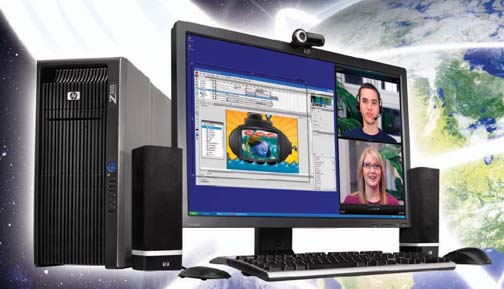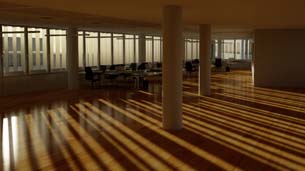Latest News
December 10, 2009
By Kenneth Wong
This year, 3,500 fewer people came to Autodesk University (AU) than last year. But at the same time, 13,500 more people attended the conference this year.
Confused? Let me explain. Last year’s AU headcount was 9,100; this year’s was 5,600. But this year, Autodesk University was taking place both onsite and in the cloud (so to speak). For the first time, Autodesk began offering people the option to register and attend the annual event online, at the convenience of your own home or office, in your dress shirt or your pajamas. Whereas AU onsite drew 5,600, AU Virtual drew 17,000 online attendees. Therefore, combined attendance for AU and AU Virtual (as reflected in the numbers registered) would amount to 22,600, a number that exceeds last year’s attendance by 13,500.
Admission cost for AU Virtually is, well, virtually free. But if you want to attend a number of classes via live streaming and listen to some archived footage, you might pay $99 for an AU Virtual Premiere pass. That’s still significantly less than the $2,400 it costs be onsite, not to mention hotel and airfare. In this economy, with travel expenses slashed to the bone, AU Virtual’s appeal is undeniable.
Chitchat in SkyRoom
Widespread adoption of WebEx, GoTo Meeting, Microsoft NetMeeting, and other browser-based conferencing utilities are evidence of the way of the future: less time on the road; more time before the monitor. People will travel if a face-to-face meeting is necessary, but for the most part they’re happy to conduct business—from pitching an idea to proposing engineering changes—in virtual conferences.
At AU exhibit hall, HP demonstrated its latest bundle that anticipates this virtual trend. Priced $149, HP SkyRoom videoconferencing promises “real-time collaboration for up to four people.” But during the initial launch (“the trial period,” as HP puts it), HP plans to include SkyRoom as a standard feature at no extra cost on HP business desktops and mobile workstations. The application is meant for sharing office documents, streaming videos, and interactive 3D applications, so you can collaborate on CAD models using SkyRoom. There’s a reason HP offers this only on its workstation and business PCs. Its system requirements are pretty high: Intel Core 2 Duo 2.33 GHz processor with 2 GB RAM.
 Fig 1. HP gets into the videoconference market with the launch of HP SkyRoom. |
Render in the Cloud
In NVIDIA’s booth (distinguishable from the logos and signs painted in NVIDIA’s margarita-green), product managers showcased NVIDIA RealityServer, In mid-October, NVIDIA publicly unveiled its GPU-based rendering system designed to take advantage of cloud computing.
The company envisions a workflow that allows people to create and view high-resolution renderings and animations, right from their browser window. RealityServer and the accompanying iRay software, for interactive ray-tracing, were originally the products of mental images, a company NVIDIA acquired in December 2007.
Products like RealityServer and iRay would play an important role in powering browser-based computing, as seen in Autodesk’s Project Twitch, Project Showroom, and Project Dragonfly, all technology previews at Autodesk Labs.
 Fig 2. NVIDIA’s RealityServer is designed to deliver highly detailed renderings with ray-tracing like this one over the Internet via cloud computing. |
3D in the Cloud
Project Twitch, which came online in September in Autodesk Labs, points to the way Autodesk plans to facilitate product trials. With Twitch, you won’t need to download and install a gigabyte-size installation file over the Internet. You simply install a small client file (about 7 MBs), then launch the trial software hosted on a remote machine. In essence, you could be using Autodesk Inventor or AutoCAD—without having either of the software installed in your machine.
The trial tittles available via Project Twitch are currently limited to just a handful: AutoCAD 2010, Autodesk Inventor 2010, and Autodesk Revit. Autodesk Maya is expected to become available on Twitch in the future.
Though currently used for delivering trial versions, Twitch’s Web-based modeling suggests other possibilities, like licensing certain titles under the software-as-a-service model. Imagine, for example, using a computing-intensive program like Autodesk 3ds Max or Alias from a browser and paying only for the time you use them. What’s more? If the provider is willing to invest in topnotch backend infrastructure, you could use a low-end consumer PC to execute your commands—parametric modeling, NURBs modeling, and rendering, to name but a few—over an Internet connection and let the remote CPU do the number crunching.
Autodesk currently has two proofs of concept for remote rendering: Project Showroom and Project Dragonfly. Showroom lets you apply different materials and render a pre-configured architectural environment (for example, a kitchen or a living room) populated with 3D replicas of household appliances that are commercially available in the market (like a Jenn Air refrigerator). Similarly, Project Dragonfly lets you visualize detailed floor plans and rooms with beds, tables, and chairs that you can drag and drop into the scene. Updates to your changes—changing tiles on the floor or wood on the kitchen cabinets—occur within just a few seconds.
Mechanical- or engineering-focused implementation of this technology might allow you to create assembly animations and photorealistic product images in short order, in far less time than it would take to accomplish the same on your own machine.
Cloudy Utopia
Twitch proves CAD in cloud is not just a fantasy; it’s a reality. As with any pioneering attempts, Twitch has certain limitations. You need a broadband connection (5 MB) for a start. Depending on the number of simultaneous users accessing the application, you might have difficulty logging in. In the current implementation, you cannot open your own files or save new files when using software in Twitch. You’re limited to playing with preloaded files. Over time, Autodesk plans to remove these barriers.
Cloud computing goes hand in hand with the move towards virtual alternatives, considered by many to be a more economical approach to doing business. As Autodesk CTO Jeff Kowalski put it, “In the future, your real world will be much more virtual, your virtual world will be much more real, and the future is coming faster than you think.”
For more on Autodesk University, read the following:
Autodesk University 2009, Part I: Cloudy with a Chance of Twitch
Autodesk University 2009, Part II: Whispered Future
Subscribe to our FREE magazine, FREE email newsletters or both!
Latest News
About the Author
Kenneth Wong is Digital Engineering’s resident blogger and senior editor. Email him at [email protected] or share your thoughts on this article at digitaleng.news/facebook.
Follow DE





